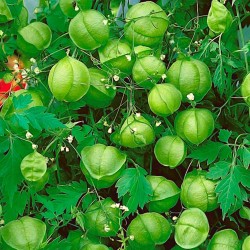Menu
-
MenuBack
- Home
-
Categories
-
-
Categories
-
Vegetable Seeds
-
Varieties by Country
- Varieties from Armenia
- Varieties from BiH
- Varieties from Croatia
- Varieties from France
- Varieties from Germany
- Varieties from Greece
- Varieties from Hungary
- Varieties from India
- Varieties from Italy
- Varieties from Japan
- Varieties from North Macedonia
- Varieties from Peru
- Varieties from Russia
- Varieties from Serbia
- Varieties from Slovenia
- Varieties from Spain
- Varieties from Thailand
- Varieties from Turkey
- Varieties from USA
- Tomato Seeds
- Corn Seeds
- Gourd family
- Bean family
- Cucumber Seeds
- Pepper Seeds
- Carrot family
- Onion family
- Lettuce Seeds
- Potato family
- Cabbage family
- Radish Seeds
- Beetroot family
- Watermelon Seeds
- Melon Seeds
- Cauliflower Seeds
- Sunflower family
-
Varieties by Country
- Fruit Seeds
- Chili - Habanero Seeds
- Medicinal Herb Seeds
- Climbing Plants Seeds
- Trees Bonsai Seeds
- Palm Seeds
- Ornamental Grasses Seeds
- Tobacco Seeds
-
Vegetable Seeds
-
-
-
-
- NEW PRODUCTS
- Create account
- Delivery - Payment
- FAQ
Last Product Reviews
Out of the two seeds, one germinated and the other one was dead and floatin...
By
 Riikka H on 07/03/2024
Riikka H on 07/03/2024
Verified Purchase
There are 103 products.
Showing 76-90 of 103 item(s)
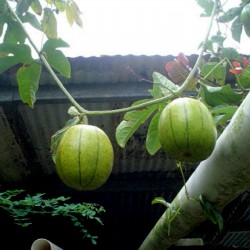
Chinese Passion Fruit Seeds...
Price
€6.25
(SKU: V 14)
Seeds Gallery EU,
5/
5
<h2 class=""><strong>Chinese Passion Fruit Seeds (Cionosicys macranthus)</strong></h2>
<h2><span style="color: #ff0000;"><strong>Price for Package of 3 seeds.</strong></span></h2>
This climbing vine in the pumpkin family is distributed from Mexico to Central America, where it grows in forests, along riverbanks and roadsides. It climbs to about 20 m and has deeply lobed leaves, creamy yellow flowers, and yellow, edible, delicious fruits, about the size of a grapefruit and similar in flavor to sweet, milky papaya. <br><br>Despite its common name in Spanish (Maracuja Chino), which translates as Chinese passion fruit, Cionosicyos macranthus is not from China and does not resemble at all a passion fruit. <br><br>It also makes a nice ornamental for tropical, humid climates.<script src="//cdn.public.n1ed.com/G3OMDFLT/widgets.js"></script>
V 14 (3 S)

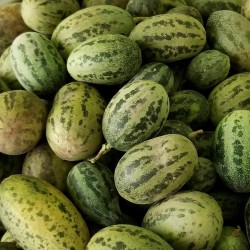
Wild Melon Seeds Cucumis...
Price
€1.75
(SKU: PK 23)
Seeds Gallery EU,
5/
5
<h2><strong>Wild Melon Seeds Cucumis melo Agrestis</strong></h2>
<h2><span style="color: #ff0000;"><strong>Price for Package of 10 seeds.</strong></span></h2>
A dainty, annual climber growing to 1.5 m (5ft), with slender stalks, rounded leaves that are serrated around the edges, and small yellow flowers followed by tiny, edible, greenish mottled to yellow fruits with whitish flesh. They can be eaten raw when ripe or cooked as a vegetable when unripe but fruits from some plants are bitter. In India, dried and powdered fruits are a popular meat tenderizer. The seeds produce edible oil.<br><br><strong>Medicinal Uses</strong><br>The fruits can be used as a cooling light cleanser or moisturizer for the skin. They are also used as a first-aid treatment for burns and abrasions. The flowers are expectorant and emetic. The fruit is stomachic. The seed is antitussive, digestive, febrifuge and vermifuge. When used as a vermifuge, the whole seed complete with the seed coat is ground into a fine flour, then made into an emulsion with water and eaten. It is then necessary to take a purge in order to expel the tapeworms or other parasites from the body. The root is diuretic and emetic. A paste of the plant is applied as a poultice around the naval when there is difficulty in urinating.
PK 23 (10 S)

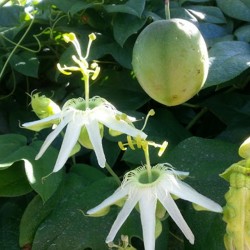
SURURUCA Seeds (Passiflora...
Price
€3.00
(SKU: V 18 PS)
Seeds Gallery EU,
5/
5
<h2><strong>SURURUCA Seeds (Passiflora setacea)</strong></h2>
<h2><span style="color: #ff0000;"><strong>Price for Package of 3 seeds.</strong></span></h2>
<p class="">Sururuca is a climbing plant with a perennial rootstock. It produces annually to perennial stems that scramble over the ground or clamber into other plants, supporting themselves by means of tendrils<br><br>The edible fruits are greatly appreciated in the plant's native range, where they are gathered from the wild.<br><br>This passion flower from southern central Brazil is found in thickets and riverine forests. It sports lobed leaves and beautiful white flowers followed by juicy, edible fruits 8 cm (orange pulp) with an excellent, mildly acidic taste.<br><br>Native to Bahia, Mato Grosso and surrounding areas of Brazil.</p><script src="//cdn.public.n1ed.com/G3OMDFLT/widgets.js"></script>
V 18 PS


Giant plant (with giant fruits)

Variety from Greece
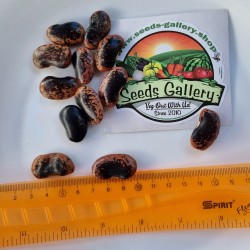
Fasolia Gigantes -...
Price
€2.45
(SKU: VE 220)
Seeds Gallery EU,
5/
5
<h2><strong>Fasolia Gigantes - Elefantes Kastorias Beans Seeds</strong></h2>
<h2 class=""><span style="color: #f80000;"><strong>Price for Package of 10 (20g) seeds.</strong></span></h2>
<div>Greek "Gigandes" beans for culinary use. The Greek giant beans are a traditional Greek food, used in several Greek gourmet recipes, such as bean soup, baked beans in the oven (butter beans), Greek salad, etc. Undoubtedly they are healthy, natural food and favorably place themselves in a Mediterranean diet.</div>
<div>
<p>Traditionally, gigandes plaki are served as a meze alongside other side dishes. However, this dish is filling enough to be eaten for lunch. This hearty meze is popular during the cold fall and winter months. As with many Greek dishes, bread is used to dip into the tomato sauce drippings.</p>
</div>
<div>Overall, gigandes plaki is healthy and nutritious food. It is a rich source of antioxidants from the tomatoes, and fiber from the other vegetables, and is suitable for vegetarians and vegans if the sausages and cheese are excluded.</div>
<h3><strong>These beans are 100% natural, this is not a hybrid or mutant product. </strong></h3>
<script src="//cdn.public.n1ed.com/G3OMDFLT/widgets.js"></script>
VE 220 (20g)

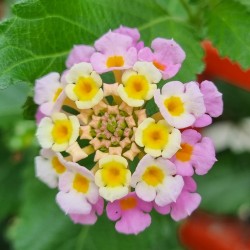
Spanish flag seeds (Lantana...
Price
€1.95
(SKU: MHS 59)
Seeds Gallery EU,
5/
5
<h2 class=""><strong>Spanish flag seeds (Lantana camara)</strong><br><span style="color: #f80000;"><strong>Price for Package of 10 seeds</strong></span></h2>
<p style="color: #202122; font-size: 14px;"><i><b>Lantana camara</b></i><span> </span>(<b>common lantana</b>) is a species of flowering plant within the<span> </span>verbena<span> </span>family (Verbenaceae), native to the American tropics.<sup id="cite_ref-florida_5-0" class="reference" style="font-size: 11.2px;"></sup><sup id="cite_ref-moyhill_6-0" class="reference" style="font-size: 11.2px;"></sup><span> </span>Other common names of<span> </span><i>L. camara</i><span> </span>include<span> </span><b>Spanish flag</b>,<span> </span><b>big-sage</b><span> </span>(Malaysia),<span> </span><b>wild-sage</b>,<span> </span><b>red-sage</b>,<span> </span><b>white-sage</b><span> </span>(Caribbean),<span> </span><b>korsu wiri</b><span> </span>or<span> </span><b>korsoe wiwiri</b><span> </span>(Suriname),<span> </span><b>tickberry</b><span> </span>(South Africa),<sup id="cite_ref-Cronk_7-0" class="reference" style="font-size: 11.2px;">[7]</sup><span> </span><b>West Indian lantana</b>,<sup id="cite_ref-plants_8-0" class="reference" style="font-size: 11.2px;">[8]</sup><span> </span><b>umbelanterna</b>,<span> </span><b>putus</b><span> </span>in Bengal and<span> </span><b>Gu Phool</b><span> </span>in Assam, India.</p>
<p style="color: #202122; font-size: 14px;">As an ornamental,<span> </span><i>L. camara</i><span> </span>is often cultivated indoors, or in a conservatory, but can also thrive in a garden with sufficient shelter in cooler climates.<sup id="cite_ref-9" class="reference" style="font-size: 11.2px;">[9]</sup><span> </span>It has spread from its native Central and South America to around 50 countries,<sup id="cite_ref-Day_10-0" class="reference" style="font-size: 11.2px;">[10]</sup><span> </span>where it has become an<span> </span>invasive species.<sup id="cite_ref-Ghisalberti2000_11-0" class="reference" style="font-size: 11.2px;">[11]</sup><sup id="cite_ref-12" class="reference" style="font-size: 11.2px;">[12]</sup><span> </span>It first spread out of the Americas when it was brought to<span> </span>Europe<span> </span>by Dutch explorers and cultivated widely, soon spreading further into<span> </span>Asia<span> </span>and<span> </span>Oceania<span> </span>where it has established itself as a notorious weed, and in Goa it was introduced by the Portuguese.<sup id="cite_ref-Ghisalberti2000_11-1" class="reference" style="font-size: 11.2px;">[11]</sup></p>
<p style="color: #202122; font-size: 14px;"><i>L. camara</i><span> </span>can outcompete native species, leading to a reduction in<span> </span>biodiversity.<sup id="cite_ref-13" class="reference" style="font-size: 11.2px;">[13]</sup><span> </span>It can also cause problems if it invades agricultural areas as a result of its toxicity to<span> </span>livestock, as well as its ability to form dense<span> </span>thickets<span> </span>which, if left unchecked, can greatly reduce the<span> </span>productivity<span> </span>of farmland.</p>
<h2 style="color: #000000; font-size: 1.5em;"><span class="mw-headline" id="Description">Description</span></h2>
<p style="color: #202122; font-size: 14px;"><i>Lantana camara</i><span> </span>is a<span> </span>perennial, erect sprawling or<span> </span>scandent, shrub which typically grows to around 2 m tall and form dense thickets in a variety of environments. In the right conditions though, it can scramble up into trees and can grow to 6 metres tall.<span> </span>Due to extensive selective breeding throughout the 17th and 18th Centuries for use as an ornamental plant, there are now many different<span> </span><i>L. camara</i><span> </span>cultivars.<sup id="cite_ref-GISD_4-1" class="reference" style="font-size: 11.2px;"><br></sup></p>
<p style="color: #202122; font-size: 14px;"><i>L. camara</i><span> </span>has small tubular shaped<span> </span>flowers, which each have four<span> </span>petals<span> </span>and are arranged in clusters in terminal areas<span> </span>stems. Flowers come in many different colours, including red, yellow, white, pink and orange, which differ depending on location in inflorescences, age, and maturity.<sup id="cite_ref-17" class="reference" style="font-size: 11.2px;">[17]</sup><span> </span>The flower has a<span> </span>tutti frutti<span> </span>smell with a peppery undertone. After<span> </span>pollination<span> </span>occurs, the colour of the flowers changes (typically from yellow to orangish, pinkish, or reddish); this is believed to be a signal to<span> </span>pollinators<span> </span>that the pre-change colour contains a reward as well as being sexually viable, thus increasing pollination efficiency.<sup id="cite_ref-18" class="reference" style="font-size: 11.2px;">[18]</sup></p>
<p style="color: #202122; font-size: 14px;">The leaves are broadly ovate, opposite, and simple and have a strong odour when crushed.<sup id="cite_ref-19" class="reference" style="font-size: 11.2px;">[19]</sup></p>
<p style="color: #202122; font-size: 14px;">The fruit of<span> </span><i>L. camara</i><span> </span>is a berry-like drupe which turns from green to dark purple when mature. Green unripe fruits are inedible to humans and animals alike. Because of dense patches of hard spikes on their rind, ingestion of them can result in serious damage to the digestive tract. Both<span> </span>vegetative<span> </span>(asexual) and<span> </span>seed<span> </span>reproduction occur. Up to 12,000<span> </span>fruits<span> </span>can be produced by each plant<sup id="cite_ref-20" class="reference" style="font-size: 11.2px;">[20]</sup><span> </span>which are then eaten by birds and other animals which can spread the seeds over large distances, facilitating the spread of<span> </span><i>L. camara</i>.</p>
<h2 style="color: #000000; font-size: 1.5em;"><span class="mw-headline" id="Distribution">Distribution</span></h2>
<span style="color: #202122; font-size: 14px;">The native range of<span> </span></span><i style="color: #202122; font-size: 14px;">Lantana camara</i><span style="color: #202122; font-size: 14px;"><span> </span>is Central and South America; however, it has become naturalised in around 60 tropical and sub-tropical countries worldwide.</span><sup id="cite_ref-feppc2_21-0" class="reference" style="color: #202122; font-size: 11.2px;">[21]</sup><sup id="cite_ref-22" class="reference" style="color: #202122; font-size: 11.2px;">[22]</sup><span style="color: #202122; font-size: 14px;"><span> </span>It is found frequently in east and southern Africa, where it occurs at altitudes below 2000 m, and often invades previously disturbed areas such as<span> </span></span>logged<span style="color: #202122; font-size: 14px;"><span> </span>forests and areas cleared for agriculture.</span><br>
<p style="color: #202122; font-size: 14px;"><i>L. camara</i><span> </span>has also colonized areas of Africa, Southern Europe, such as Spain and Portugal, and also the Middle East, India, tropical Asia, Australia, New Zealand, and the US, as well as many Atlantic, Pacific and Indian Ocean islands.<sup id="cite_ref-24" class="reference" style="font-size: 11.2px;">[24]</sup><sup id="cite_ref-Thaman_25-0" class="reference" style="font-size: 11.2px;">[25]</sup><span> </span>It has become a significant weed in Sri Lanka after escaping from the<span> </span>Royal Botanic gardens<span> </span>in 1926.<sup id="cite_ref-fao_26-0" class="reference" style="font-size: 11.2px;">[26]</sup><sup id="cite_ref-27" class="reference" style="font-size: 11.2px;">[27]</sup></p>
<p style="color: #202122; font-size: 14px;">It was introduced into the Philippines from Hawaii as part of an exchange program between the United States and the Philippines; however, it managed to escape and has become naturalized in the islands.<sup id="cite_ref-28" class="reference" style="font-size: 11.2px;">[28]</sup><span> </span>It has also been introduced to the whole southern US, from<span> </span>California<span> </span>to<span> </span>North Carolina,<sup id="cite_ref-plants.usda.gov_29-0" class="reference" style="font-size: 11.2px;">[29]</sup><span> </span>and is considered hardy in USDA zones 10 and 11.<sup id="cite_ref-30" class="reference" style="font-size: 11.2px;">[30]</sup></p>
<p style="color: #202122; font-size: 14px;">The range of<span> </span><i>L. camara</i><span> </span>is still increasing, shown by the fact that it has invaded many islands on which it was not present in 1974, including the<span> </span>Galapagos Islands,<span> </span>Saipan<span> </span>and the<span> </span>Solomon Islands.<sup id="cite_ref-Thaman_25-1" class="reference" style="font-size: 11.2px;">[25]</sup><span> </span>There is also evidence that<span> </span><i>L. camara</i><span> </span>is still increasing its range in areas where it has been established for many years, such as East Africa, Australia and New Zealand.<sup id="cite_ref-Day_10-1" class="reference" style="font-size: 11.2px;">[10]</sup><span> </span>The ability of<span> </span><i>L. camara</i><span> </span>to rapidly colonise areas of land which have been disturbed has allowed it to proliferate in countries where activities such as logging, clearance for agriculture and<span> </span>forest fires<span> </span>are common. In contrast, in countries with large areas of intact primary forest, the distribution of<span> </span><i>L. camara</i><span> </span>has been limited.</p>
<h3 style="color: #000000; font-size: 1.2em;"><span class="mw-headline" id="Habitat">Habitat</span></h3>
<div class="thumb tright" style="color: #202122; font-size: 14px;">
<div class="thumbinner" style="font-size: 13.16px;"><img alt="" src="https://upload.wikimedia.org/wikipedia/commons/thumb/8/80/Lantana_camara-Silent_Valley-2016-08-14-001.jpg/220px-Lantana_camara-Silent_Valley-2016-08-14-001.jpg" decoding="async" width="220" height="147" class="thumbimage" srcset="//upload.wikimedia.org/wikipedia/commons/thumb/8/80/Lantana_camara-Silent_Valley-2016-08-14-001.jpg/330px-Lantana_camara-Silent_Valley-2016-08-14-001.jpg 1.5x, //upload.wikimedia.org/wikipedia/commons/thumb/8/80/Lantana_camara-Silent_Valley-2016-08-14-001.jpg/440px-Lantana_camara-Silent_Valley-2016-08-14-001.jpg 2x" data-file-width="6000" data-file-height="4000">
<div class="thumbcaption" style="font-size: 12.3704px;">
<div class="magnify"></div>
<i>L. camara</i><span> </span>in<span> </span>Silent Valley National Park,<span> </span>Kerala,<span> </span>India</div>
</div>
</div>
<p style="color: #202122; font-size: 14px;"><i>Lantana camara</i><span> </span>is found in a variety of environments, including:</p>
<ul style="color: #202122; font-size: 14px;">
<li>Agricultural areas</li>
<li>Forest margins and gaps</li>
<li>Riparian<span> </span>zones</li>
<li>Grasslands</li>
<li>Secondary forest, and</li>
<li>Beach fronts.</li>
</ul>
<p style="color: #202122; font-size: 14px;"><i>L. camara</i><span> </span>is rarely found in natural or semi-natural areas of forest, as it is unable to compete with taller trees due to its lack of tolerance for shade. Instead, it grows at the forest edge.<span> </span><i>L. camara</i><span> </span>can survive in a wide range of climatic conditions, including<span> </span>drought, different soil types, heat, humidity, and salt. It is also relatively fired tolerant and can quickly establish itself in recently burnt areas of forest.</p>
<h3 style="color: #000000; font-size: 1.2em;"><span class="mw-headline" id="Invasive_species">Invasive species</span></h3>
<div class="thumb tright" style="color: #202122; font-size: 14px;">
<div class="thumbinner" style="font-size: 13.16px;"><img alt="" src="https://upload.wikimedia.org/wikipedia/commons/thumb/4/4d/Lantana_camara_tree.jpg/220px-Lantana_camara_tree.jpg" decoding="async" width="220" height="316" class="thumbimage" srcset="//upload.wikimedia.org/wikipedia/commons/thumb/4/4d/Lantana_camara_tree.jpg/330px-Lantana_camara_tree.jpg 1.5x, //upload.wikimedia.org/wikipedia/commons/thumb/4/4d/Lantana_camara_tree.jpg/440px-Lantana_camara_tree.jpg 2x" data-file-width="891" data-file-height="1279">
<div class="thumbcaption" style="font-size: 12.3704px;">
<div class="magnify"></div>
6 metre tall<span> </span><i>L. camara</i><span> </span>shrubs infesting a native woodland area in<span> </span>Sydney.</div>
</div>
</div>
<p style="color: #202122; font-size: 14px;"><i>L. camara</i><span> </span>is considered to be a weed in large areas of the<span> </span>Paleotropics<span> </span>where it has established itself. In agricultural areas or secondary forests it can become the dominant understorey shrub, crowding out other native species and reducing biodiversity.<sup id="cite_ref-Cronk_7-2" class="reference" style="font-size: 11.2px;">[7]</sup><span> </span>The formation of dense thickets of<span> </span><i>L. camara</i><span> </span>can significantly slow down the regeneration of forests by preventing the growth of new trees.<sup id="cite_ref-GISD_4-2" class="reference" style="font-size: 11.2px;">[4]</sup></p>
<p style="color: #202122; font-size: 14px;">In the US,<span> </span><i>L. camara</i><span> </span>is considered invasive in tropical areas such as<span> </span>Florida<span> </span>and<span> </span>Hawaii.<sup id="cite_ref-plants.usda.gov_29-1" class="reference" style="font-size: 11.2px;">[29]</sup></p>
<p style="color: #202122; font-size: 14px;">Although<span> </span><i>L. camara</i><span> </span>is itself quite resistant to fire, it can change fire patterns in a forest<span> </span>ecosystem<span> </span>by altering the fuel load, causing a buildup of forest fuel, which itself increases the risk of fires spreading to the<span> </span>canopy.<sup id="cite_ref-33" class="reference" style="font-size: 11.2px;">[33]</sup><span> </span>This can be particularly destructive in dry, arid areas where fire can spread quickly and lead to the loss of large areas of natural ecosystem.</p>
<p style="color: #202122; font-size: 14px;"><i>L. camara</i><span> </span>reduces the productivity in pasture through the formation of dense thickets, which reduce growth of crops as well as make harvesting more difficult. There are also secondary impacts, including the finding that in Africa,<span> </span>mosquitos<span> </span>which transmit<span> </span>malaria<span> </span>and<span> </span>tsetse<span> </span>flies shelter within the bushes of<span> </span><i>L. camara</i>.<sup id="cite_ref-34" class="reference" style="font-size: 11.2px;">[34]</sup></p>
<p style="color: #202122; font-size: 14px;">Even though<span> </span><i>L. camara</i><span> </span>is considered invasive to the<span> </span>Western Ghats, the plant does not seem to impact biodiversity in the region; rather it tends to simply occupy the same moist regions as other species.<sup id="cite_ref-35" class="reference" style="font-size: 11.2px;">[35]</sup></p>
<p style="color: #202122; font-size: 14px;">There are many reasons why<span> </span><i>L. camara</i><span> </span>has been so successful as an invasive species; however, the primary factors which have allowed it to establish itself are:</p>
<ol style="color: #202122; font-size: 14px;">
<li>Wide dispersal range made possible by birds and other animals that eat its drupes</li>
<li>Less prone to being eaten by animals due to toxicity</li>
<li>Tolerance of a wide range of environmental conditions<sup id="cite_ref-Cronk_7-3" class="reference" style="font-size: 11.2px;">[7]</sup></li>
<li>Increase in logging and habitat modification, which has been beneficial to<span> </span><i>L. camara</i><span> </span>as it prefers disturbed habitats</li>
<li>Production of toxic chemicals which inhibit competing plant species</li>
<li>Extremely high seed production (12,000 seeds from each plant per year)<sup id="cite_ref-36" class="reference" style="font-size: 11.2px;">[36]</sup></li>
</ol>
<h3 style="color: #000000; font-size: 1.2em;"><span class="mw-headline" id="Toxicity">Toxicity</span></h3>
<div class="thumb tleft" style="color: #202122; font-size: 14px;">
<div class="thumbinner" style="font-size: 13.16px;"><img alt="" src="https://upload.wikimedia.org/wikipedia/commons/thumb/8/81/Lantana_camara_%2855%29.jpg/220px-Lantana_camara_%2855%29.jpg" decoding="async" width="220" height="146" class="thumbimage" srcset="//upload.wikimedia.org/wikipedia/commons/thumb/8/81/Lantana_camara_%2855%29.jpg/330px-Lantana_camara_%2855%29.jpg 1.5x, //upload.wikimedia.org/wikipedia/commons/thumb/8/81/Lantana_camara_%2855%29.jpg/440px-Lantana_camara_%2855%29.jpg 2x" data-file-width="600" data-file-height="399">
<div class="thumbcaption" style="font-size: 12.3704px;">
<div class="magnify"></div>
<i>L. camara</i></div>
</div>
</div>
<p style="color: #202122; font-size: 14px;"><i>Lantana camara</i><span> </span>is known to be toxic to livestock such as cattle, sheep, horses, dogs and goats.<sup id="cite_ref-37" class="reference" style="font-size: 11.2px;">[37]</sup><sup id="cite_ref-38" class="reference" style="font-size: 11.2px;">[38]</sup><span> </span>The active substances causing toxicity in grazing animals are<span> </span>pentacyclic<span> </span>triterpenoids, which result in liver damage and photosensitivity.<sup id="cite_ref-39" class="reference" style="font-size: 11.2px;">[39]</sup><span> </span><i>L. camara</i><span> </span>also excretes<span> </span>allelopathic<span> </span>chemicals, which reduce the growth of surrounding plants by inhibiting<span> </span>germination<span> </span>and root elongation.<sup id="cite_ref-40" class="reference" style="font-size: 11.2px;">[40]</sup></p>
<p style="color: #202122; font-size: 14px;">The toxicity of<span> </span><i>L. camara</i><span> </span>to humans is undetermined, with several studies suggesting that ingesting berries can be toxic to humans, such as a study by O P Sharma which states "Green unripe fruits of the plant are toxic to humans".<sup id="cite_ref-41" class="reference" style="font-size: 11.2px;">[41]</sup><span> </span>NC State's Extension Gardener website states that ingestion of the flowers, fruits, and leaves can cause vomiting, diarrhea, difficulty breathing, and liver failure, while the leaves can cause contact dermatitis.<sup id="cite_ref-42" class="reference" style="font-size: 11.2px;">[42]</sup><span> </span>However, other studies have found evidence which suggests that<span> </span><i>L. camara</i><span> </span>fruit poses no risk to humans when eaten, and is in fact edible when ripe.<sup id="cite_ref-43" class="reference" style="font-size: 11.2px;">[43]</sup><sup id="cite_ref-44" class="reference" style="font-size: 11.2px;">[44]</sup></p>
<h2 style="color: #000000; font-size: 1.5em;"><span class="mw-headline" id="Management_and_control">Management and control</span></h2>
<div class="thumb tright" style="color: #202122; font-size: 14px;">
<div class="thumbinner" style="font-size: 13.16px;"><img alt="Butterfly feeding on Lantana camara" src="https://upload.wikimedia.org/wikipedia/commons/thumb/e/e2/Graphium_sarpedon_WQXGA.jpg/220px-Graphium_sarpedon_WQXGA.jpg" decoding="async" width="220" height="138" class="thumbimage" srcset="//upload.wikimedia.org/wikipedia/commons/thumb/e/e2/Graphium_sarpedon_WQXGA.jpg/330px-Graphium_sarpedon_WQXGA.jpg 1.5x, //upload.wikimedia.org/wikipedia/commons/thumb/e/e2/Graphium_sarpedon_WQXGA.jpg/440px-Graphium_sarpedon_WQXGA.jpg 2x" data-file-width="2560" data-file-height="1600">
<div class="thumbcaption" style="font-size: 12.3704px;">
<div class="magnify"></div>
Butterfly feeding on<span> </span><i>L. camara</i></div>
</div>
</div>
<p style="color: #202122; font-size: 14px;">Effective management of invasive<span> </span><i>L. camara</i><span> </span>in the long term will require a reduction in activities that create degraded habitats. Maintaining functioning (healthy) ecosystems is key to preventing invasive species from establishing themselves and out-competing native<span> </span>fauna<span> </span>and<span> </span>flora.</p>
<h3 style="color: #000000; font-size: 1.2em;"><span class="mw-headline" id="Biological">Biological</span></h3>
<p style="color: #202122; font-size: 14px;">Insects and other<span> </span>biocontrol<span> </span>agents have been implemented with varying degrees of success in an attempt to control<span> </span><i>L. camara</i>. It was the first weed ever subjected to biological control; however, none of the programs have been successful despite 36 control agents being used across 33 regions.<sup id="cite_ref-Management_Information_45-0" class="reference" style="font-size: 11.2px;">[45]</sup></p>
<p style="color: #202122; font-size: 14px;">The lack of success using biological control in this case is most likely due to the many<span> </span>hybrid<span> </span>forms of<span> </span><i>L. camara</i>, as well as its large<span> </span>genetic diversity<span> </span>which makes it difficult for the control agents to target all plants effectively. A recent study in India has shown some results around biological control of this plant using tingid bugs.<sup id="cite_ref-46" class="reference" style="font-size: 11.2px;">[46]</sup></p>
<h3 style="color: #000000; font-size: 1.2em;"><span class="mw-headline" id="Mechanical">Mechanical</span></h3>
<p style="color: #202122; font-size: 14px;">Mechanical control of<span> </span><i>L. camara</i><span> </span>involves physically removing the plants. Physical removal can be effective but is labor-intensive and expensive,<span> </span>therefore removal is usually only appropriate in small areas or at the early stages of an infestation. Another method of mechanical control is to use fire treatment, followed by revegetation with native species.</p>
<h3 style="color: #000000; font-size: 1.2em;"><span class="mw-headline" id="Chemical">Chemical</span></h3>
<p style="color: #202122; font-size: 14px;">Using herbicides to manage<span> </span><i>L. camara</i><span> </span>is very effective but also expensive, prohibiting its use in many poorer countries where<span> </span><i>L. camara</i><span> </span>is well established. The most effective way of chemically treating plant species is to first mow the area, then spray the area with a<span> </span>weed-killer, although this may have serious environmental consequences.</p>
<h2 style="color: #000000; font-size: 1.5em;"><span class="mw-headline" id="Uses">Uses</span></h2>
<div class="thumb tright" style="color: #202122; font-size: 14px;">
<div class="thumbinner" style="font-size: 13.16px;"><img alt="Butterfly resting on L. camara" src="https://upload.wikimedia.org/wikipedia/commons/thumb/2/2e/Butterfly_on_Lantana_-_Flickr_-_Andrea_Westmoreland.jpg/220px-Butterfly_on_Lantana_-_Flickr_-_Andrea_Westmoreland.jpg" decoding="async" width="220" height="156" class="thumbimage" srcset="//upload.wikimedia.org/wikipedia/commons/thumb/2/2e/Butterfly_on_Lantana_-_Flickr_-_Andrea_Westmoreland.jpg/330px-Butterfly_on_Lantana_-_Flickr_-_Andrea_Westmoreland.jpg 1.5x, //upload.wikimedia.org/wikipedia/commons/thumb/2/2e/Butterfly_on_Lantana_-_Flickr_-_Andrea_Westmoreland.jpg/440px-Butterfly_on_Lantana_-_Flickr_-_Andrea_Westmoreland.jpg 2x" data-file-width="5098" data-file-height="3618">
<div class="thumbcaption" style="font-size: 12.3704px;">
<div class="magnify"></div>
Butterfly resting on<span> </span><i>L. camara</i></div>
</div>
</div>
<p style="color: #202122; font-size: 14px;"><i>Lantana camara</i><span> </span>stalks have been used in the construction of furniture, such as chairs and tables;<span> </span>however, the main uses have historically been medicinal and ornamental.</p>
<h3 style="color: #000000; font-size: 1.2em;"><span class="mw-headline" id="Medicinal_value">Medicinal value</span></h3>
<p style="color: #202122; font-size: 14px;">Studies conducted in India have found that<span> </span><i>Lantana</i><span> </span>leaves can display<span> </span>antimicrobial,<span> </span>fungicidal,<span> </span>and<span> </span>insecticidal<span> </span>properties.<span> </span><i>L. camara</i><span> </span>has also been used in traditional herbal medicines for treating a variety of ailments, including<span> </span>cancer, skin itches,<span> </span>leprosy,<span> </span>chickenpox,<span> </span>measles,<span> </span>asthma,<span> </span>and<span> </span>ulcers.<sup id="cite_ref-GISD_4-4" class="reference" style="font-size: 11.2px;">[4]</sup></p>
<p style="color: #202122; font-size: 14px;"><i>L. camara</i><span> </span>extract has been shown to reduce gastric<span> </span>ulcer<span> </span>development in rats.<sup id="cite_ref-49" class="reference" style="font-size: 11.2px;">[49]</sup><span> </span>Extracts from the plant have also been used in Brazil to treat respiratory infections.<sup id="cite_ref-50" class="reference" style="font-size: 11.2px;">[50]</sup></p>
<h3 style="color: #000000; font-size: 1.2em;"><span class="mw-headline" id="Ornamental">Ornamental</span></h3>
<p style="color: #202122; font-size: 14px;"><i>Lantana camara</i><span> </span>has been grown specifically for use as an ornamental plant since Dutch explorers first brought it to Europe from the New World.<sup id="cite_ref-GISD_4-5" class="reference" style="font-size: 11.2px;">[4]</sup><span> </span>Its ability to last for a relatively long time without water, and the fact that it does not have many pests or diseases which affect it, have contributed to it becoming a common ornamental plant.<span> </span><i>L. camara</i><span> </span>also attracts butterflies and birds and is frequently used in butterfly gardens.<sup id="cite_ref-florida_5-1" class="reference" style="font-size: 11.2px;">[5]</sup></p>
<h3 style="color: #000000; font-size: 1.2em;"><span class="mw-headline" id="As_a_host-plant">As a host-plant</span></h3>
<p style="color: #202122; font-size: 14px;">Many butterfly species feed on the nectar of<span> </span><i>L. camara.</i><span> </span><i>Papilio homerus</i>, the largest butterfly in the western hemisphere, is known to feed on the nectar of the flowers as an opportunistic flower feeder.<sup id="cite_ref-51" class="reference" style="font-size: 11.2px;">[51]</sup><span> </span>A jumping spider<span> </span><i>Evarcha culicivora</i><span> </span>has an association with<span> </span><i>L. camara</i>. They consume the nectar for food and preferentially use these plants as a location for courtship.<sup id="cite_ref-:2_52-0" class="reference" style="font-size: 11.2px;">[52]</sup></p>
<h2 style="color: #000000; font-size: 1.5em;"><span class="mw-headline" id="Etymology">Etymology</span></h2>
<p style="color: #202122; font-size: 14px;">The name<span> </span><i>Lantana</i><span> </span>derives from the<span> </span>Latin<span> </span>name of the wayfaring tree<span> </span><i>Viburnum lantana</i>, the flowers of which closely resemble<span> </span><i>Lantana</i>.<sup id="cite_ref-Ghisalberti2000_11-2" class="reference" style="font-size: 11.2px;">[11]</sup><sup id="cite_ref-gledhill_53-0" class="reference" style="font-size: 11.2px;">[53]</sup></p>
<p style="color: #202122; font-size: 14px;"><i>Camara</i><span> </span>is derived from<span> </span>Greek, meaning ‘arched’, ‘chambered’, or ‘vaulted’.</p>
<br>
<script src="//cdn.public.n1ed.com/G3OMDFLT/widgets.js"></script>
MHS 59 (10 S)


Giant plant (with giant fruits)

Variety from Armenia
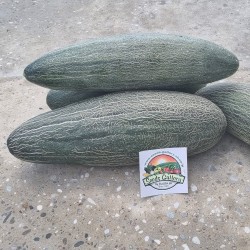
Giant Armenian reticulate...
Price
€2.25
(SKU: PK 30)
Seeds Gallery EU,
5/
5
<h2><strong>Giant Armenian reticulate Cucumber Melon seeds</strong></h2>
<h2><span style="color: #ff0000;"><strong>Price for Package of 5 seeds.</strong></span></h2>
Armenian reticulate cucumber is a variety that is very difficult to find. The fruits are up to 50 cm long, dark green with a mesh, and can reach a weight of 3 kg.<br /><br />The plant produces good yields of 40-50 cm long thick dark green cucumbers. Best to harvest the fruits when is 30 cm long. This is one of the biggest cucumbers on the market. It is an excellent and perfect cucumber for salads and gourmet dishes. It has a crisp mild flavor and is easy to digest. The fruits are ready for harvest in 50 days. <br /><br />Impress your neighbors and grow a giant cucumber in your home garden!
<script src="//cdn.public.n1ed.com/G3OMDFLT/widgets.js"></script>
PK 30 (10 S)


Giant plant (with giant fruits)

Plant resistant to cold and frost
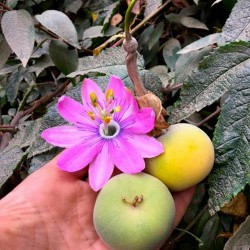
Tauso Seeds (Passiflora...
Price
€3.50
(SKU: V 120)
Seeds Gallery EU,
5/
5
<h2 class=""><strong>Tauso Seeds (Passiflora coactilis)</strong></h2>
<h2><span style="color: #ff0a0a;"><strong>Price for Package of 3 seeds.</strong></span></h2>
A vigorous, evergreen climber with trilobed leaves and pink flowers followed by round, yellowish fruits that are edible and aromatic. Passiflora coactilis is a plant from cool, high elevation cloud forests in the Andes in South America in southwestern Colombia and in Ecuador between 2200 and 3600 m. it is well adapted to cool conditions and will grow in many warm temperate climates in USDA Zones 9 and above. <br><br><strong>In frosty weather, leaves and shoots may be damaged but will regrow from the base in spring.</strong>
<script src="//cdn.public.n1ed.com/G3OMDFLT/widgets.js"></script>
V 120 (3 S)


Plant resistant to cold and frost
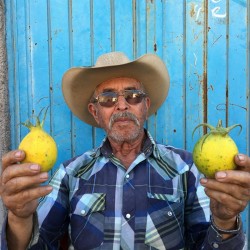
Jarilla Seeds (Jarilla...
Price
€7.95
(SKU: V 72)
Seeds Gallery EU,
5/
5
<h2 class=""><strong>Jarilla Seeds (Jarilla caudata)</strong></h2>
<h2><span style="color: #ff0a0a;"><strong>Price for a Package of 3 seeds.</strong></span></h2>
Jarilla caudata is a rather unspectacular plant and papaya relative with quite extraordinary and highly unusual fruits. An upright or creeping, dry deciduous, herbaceous perennial, native to Mexico and Central America, where it grows in xerophytic scrubland and deciduous forests, at elevations between 1500 and 2000 m. <br><br>Similar to Jarilla heterophylla, it produces a succulent tuber that holds green or purplish-green stems branching from the base with oval to lanceolate leaves and whitish flowers with occasional streaks of purple. The flowers are followed by oblong to elliptical fruits that can reach up to 30 cm in length, with long, horn-like projections. They are mottled in lighter and darker shades of green and turn yellow when ripe while the "horns" turn purplish. <br><br>The fruits are edible and occasionally found in local markets. Soft fruits are eaten raw while fully mature ones are used to make a refreshing beverage from their juice. According to one old Mexican recipe, Jarilla caudata fruits can also be used to make preserves and they are especially delicious when combined with coconut. <br><br>This relative of the papaya will grow well in most warm temperate climates to at least USDA Zone 9 and even survive some drought and cold. It would be an interesting species for hybridization with other papaya relatives.
<script src="//cdn.public.n1ed.com/G3OMDFLT/widgets.js"></script>
V 72 (3 S)


Plant resistant to cold and frost
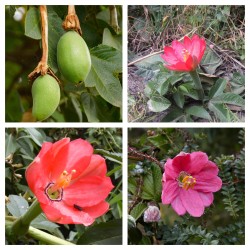
Tumbo Seeds (Passiflora mixta)
Price
€3.50
(SKU: V 83)
Seeds Gallery EU,
5/
5
<h2 class=""><strong>Tumbo Seeds (Passiflora mixta)</strong></h2>
<h2><span style="color: #ff0a0a;"><strong>Price for a Package of 3 seeds.</strong></span></h2>
<br>Passiflora mixta is well adapted to cool conditions and will grow in many warm temperate climates in USDA Zones 9 and above.<br><br>Tags: child and pet friendly, climber, edible fruit, evergreen, flowering, malpighiales, mixta, ornamental, passiflora, potted, tumbo...<br><br>
<h2 style="color: #1a1a1a; font-size: 30px;"><span class="mw-headline" id="Germination">Germination</span></h2>
<p style="color: #333333; font-size: 16px;"><i>Passiflora mixta</i><span> </span>seeds take approximately 30–365 days to germinate and even under optimal conditions their growth may be erratic. The seeds should be planted 6 mm (0.24 in) deep in a peaty seed sowing mix at about 20–30 °C (68–86 °F). new water should be used every day and it is necessary to soak them under warm water. This process will cause some seeds to swell up; these seeds should be sown instantly. On occasion, it is also important to soak the container in which the seeds are placed.<span> </span></p>
<script src="//cdn.public.n1ed.com/G3OMDFLT/widgets.js"></script>
V 83 (3 S)

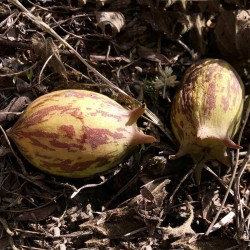
Granadina Seeds (Jarilla...
Price
€8.95
(SKU: V 105)
Seeds Gallery EU,
5/
5
<h2><strong>Granadina Seeds (Jarilla heterophylla)</strong></h2>
<h2><span style="color: #ff0a0a;"><strong>Price for a Package of 3 seeds.</strong></span></h2>
A forgotten relative of the common papaya, this creeping or decumbent herbaceous perennial is found in oak and deciduous forests and secondary habitats from Mexico to Central America at elevations between 1500 and 2700 m. <br><br>It only grows up to 1 m tall from a fleshy, spherical, tuberous root, about 15-20 cm in diameter. The delicate stems are branching from the base and hold undulate or toothed leaves and whitish flowers with occasional touches of purple that are followed by curious, horned, globose fruits, about 2.5 cm in diameter and green to purplish with white streaks. <br><br>The fruits of Jarilla heterophylla are occasionally found in rural markets in Mexico and highly appreciated for their fragrant, pleasant and aromatic taste with citrus and mustard notes. <br><br>They are typically made into preserves and sauces accompanying different meats.<br><br>Tags: brassicales, caric, deciduous perennial, edible fruit, granadina, heterophylla, jarilla, jarill, nana<script src="//cdn.public.n1ed.com/G3OMDFLT/widgets.js"></script>
V 105 (3 S)

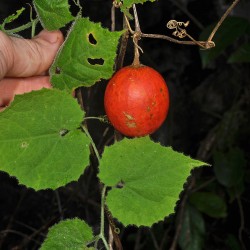
Japanese snake gourd seeds...
Price
€2.45
(SKU: VG 32)
Seeds Gallery EU,
5/
5
<h2><strong>Japanese snake gourd seeds (Trichosanthes pilosa)</strong></h2>
<h2><span style="color: #ff0000;"><strong>Price for Package of 5 seeds.</strong></span></h2>
<p>A climbing plant in the pumpkin family with thin shoots, lobed leaves, and white flowers with frilly edges, followed by round, bright red fruits that hold seeds coated in slimy black mucus. Trichosanthes pilosa is widespread from the Himalayas to tropical eastern Asia to 1300 m. The roasted seeds are a popular snack in parts of Asia.</p>
<p>Japanese snake gourd is a perennial, climbing plant producing stems that can sprawl over the ground or climb into other plants for support, attaching themselves by means of tendrils.<br />The plant is cultivated, especially in China, for its edible fruit and root, and also for traditional medicinal purposes</p>
<p>Cultivation Details<br />Requires rich well-drained soil and plenty of moisture in the growing season.</p>
<p>Edible Uses<br />An edible starch is obtained from the root.<br />The immature fruit is preserved in salt. The mature fruit is about 7cm long.</p>
<p>Medicinal<br />Yields the protein hetero-trichosanthin, with 1.7 times the abortifacient activity of trichosanthin from the related species T. Kirilowii.</p>
<p>Diuretic<br />The root is anodyne, antiphlogistic, blood purifier, depurative, febrifuge, and resolvent. It is used as a poultice or made into a decoction to treat abscesses, boils, fevers, sore throats, etc.<br />The fruit is used to treat coughs, diabetes, jaundice, etc.</p>
<p>Other Uses<br />The dried fruit is rich in saponins and is used as a soap substitute.<br />An industrial starch is obtained from the root.</p>
<p>Propagation<br />Seed - sow March in pots in a warm greenhouse in rich soil. Sow 2 - 3 seeds per pot and thin to the strongest plant. Grow them on fast and plant out after the last expected frosts. Give some protection, such as a frame or cloche, until the plants are growing away well.</p>
VG 32 (5 S)


Plant resistant to cold and frost
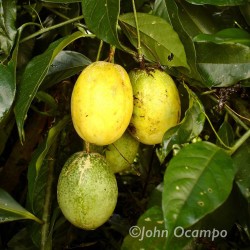
Perfect Passionfruit Seeds...
Price
€3.15
(SKU: V 210)
Seeds Gallery EU,
5/
5
<h2><strong>Perfect Passionfruit Seeds (Passiflora popenovii)</strong></h2>
<h2><span style="color: #ff0000;"><strong>Price for Package of 3 seeds.</strong></span></h2>
<p>The rare Passiflora popenovii gives probably the most delicious fruit of all Passiflora species. The transparent and very juicy flesh inside the soft shell of the bright yellow fruit is extremely sweet and has an exceptional, exotic, and fragrant taste.</p>
<p>It originates from the rainforests of Colombia and Ecuador between 500 and 1900 m (1600 and 6200 feet) but is believed to have become extinct in the wild and to be grown only locally. It will easily adapt to growing in a wide range of climatic conditions.</p>
<p>We think that Perfect Passionfruit has the potential to become far more popular than Passiflora edulis or Passiflora ligularis, which are common in fruit markets around the world.</p>
<p>Cold hardy to -6C</p>
V 210 (3 S)


Plant resistant to cold and frost
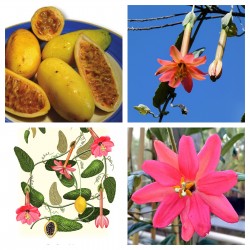
Passiflora adulterina Seeds
Price
€4.85
(SKU: V 22 PAS)
Seeds Gallery EU,
5/
5
<h2><strong>Passiflora adulterina Seeds</strong></h2>
<h2><span style="color: #ff0808;"><strong>Price for Package of 5 seeds.</strong></span></h2>
<p>A rare Passiflora species was discovered in Colombia in 2015.<br />Evergreen perennial climber 5 m (up to 20 m in nature) with alternate, elliptic, deep green, veined leaves, and finely serrate leaf margins. The long, pendulous pink flowers appear in the leaf axils, followed by showy edible, and tasty fruits. It bears many fruits in the shape of papaya.</p>
<p>In winter, it usually loses the above-ground part, so in the spring, young shoots sprout again. It blooms from spring to autumn. It is stored outdoors from spring to autumn, and in a cool room in winter.</p>
<p>Winter hardy to -6C</p>
V 22 PAS (5 S)

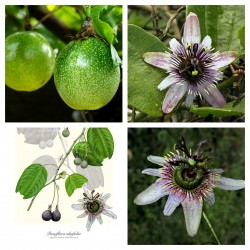
Passiflora alnifolia Seeds
Price
€3.55
(SKU: V 28 PA)
Seeds Gallery EU,
5/
5
<h2><strong>Passiflora alnifolia Seeds</strong></h2>
<h2><span style="color: #ff0808;"><strong>Price for Package of 5 seeds.</strong></span></h2>
<p>A slender, tendriled climbing plant with bifid leaves and white, purple, and lavender sweetly-perfumed flowers are followed by small delicious fruits on this slender, tendriled climbing plant which has unlobed. Passiflora alnifolia is native to montane rainforests and cloud forests of the Andes mainly in Colombia and Ecuador between 1700 to 3200 m.</p>
<p>This plant will provide nectar and pollen for bees, butterflies, and many other types of pollinating insects.</p>
V 28 PA (5 S)





